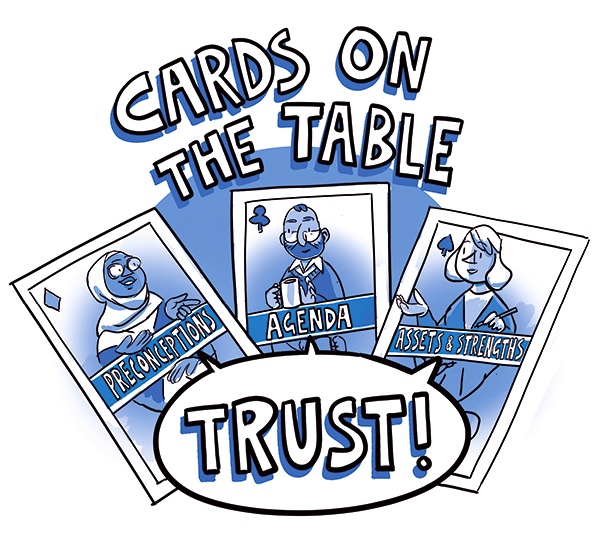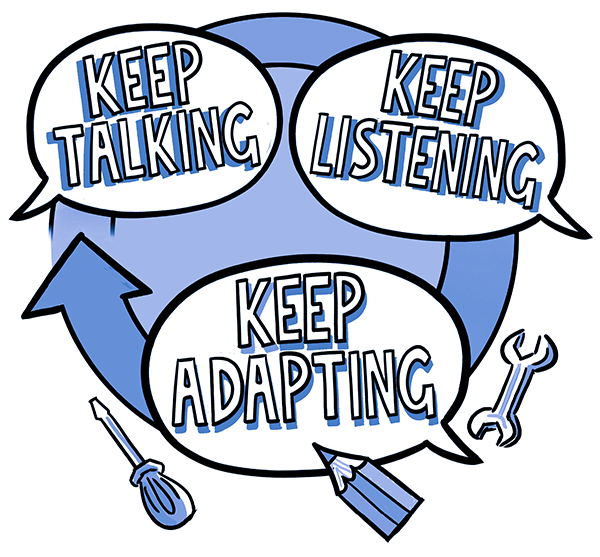Allow enough time
Partnership building requires an investment of time for both sides that should not be taken lightly, and it should have an organisation-level commitment.
Building trust takes time and patience: it is a process that cannot be rushed or fast-tracked. Time needs to be built in to allow for trust to grow at its own pace.
P. Bienkowski and H. McGowan, Managing Change in Museums and Galleries

This point cannot be underestimated and is an important reason to put your cards on the table and find out early on if your aims and objectives align. Partnership building requires an investment of time for both sides that should not be taken lightly, and it should have an organisation-level commitment.
Short-term or pilot community projects often do more harm than good. Science engagement partners can come across as disrespectful or disingenuous if only partnering to deliver to their immediate funding requirements. This can also damage opportunities for future partnerships and trust from the participants.
Working long-term and building trust with a community partner should be the goal for greater depth and sustained impact on both sides. Think beyond projects and embark on partner relationships with an open-ended expectation that it will continue beyond the project delivery.
The shared high activity of a funded project is a great way to develop a partnership through exploring working practices together, but long-term outcomes can go way beyond this, for example, changing representation within your staff team or renewing policies and practice.
The value of partnerships beyond ‘reaching a new audience’ is explored further in the ‘catalysing organisational change’ section.
They didn't just come in and get stuck in there. They'd come in and they took time to speak to them and get to know them and get to write down what their likes and dislikes were.
Community Partner, Wrexham (talking about Xplore! Science Discovery Centre)
Start to develop a mutual and increasing understanding of each other’s expectations, objectives and assets. Be interested beyond what it means for you in the relationship and focus on the motivations and benefits for your community partner.
Be generous with your time and support them with their requests whenever you can.
TOP TIP
If resources allow at the start, set your STEM agenda aside and visit one of your community partners’ events. This might be a celebration event, an AGM, or to observe one of their regular sessions. Getting to know them in their context, and the way they work successfully with each other, will help you learn from their expertise and enable you to frame your interactions, as well as showing your commitment to the partnership from the start.
Keep talking, keep listening and keep adapting. A clear emphasis on regular, open communication will allow you to be more flexible and responsive to the needs of your community partner.
Case Study from Explore Your Universe
Edinburgh Young Carers, working with Dynamic Earth, noted that although their work together was ‘a priority’, other things that happened were simply more urgent. Dynamic Earth (and other science centres who felt they had successful experiences) reported that managing expectations and maintaining flexibility over what partners could realistically commit to was crucial. Internal communication within the science centre, museum or university (e.g. with all delivery staff involved) was also important so everyone interacting with the partner organisation understood their partners’ challenges, aims and priorities.
Working in partnership we can all work towards transforming the field in ways that support science centres and science museums to become meaningfully inclusive, welcoming and relevant to everyone.
Emily Dawson, Associate Professor, Department of Science and Technology Studies (STS), UCL

Budgets, staff and priorities can change rapidly and dramatically. Within Explore Your Universe, the strongest partnerships were where science centre practitioners were constantly responsive, respectful and adapted around the needs of their community partner.
TOP TIP
During Explore Your Universe, building equitable, open and trusted partnerships, that worked for the mutual benefit of all organisations, was the foundational bedrock for the most meaningful and successful participant engagements.
Move at the speed of trust. Focus on critical connections more than critical mass - build the resilience by building the relationships.
Adrienne Maree Brown, author, activist
Create a relationship action plan
Logistical support is essential to engaging participants from marginalised groups. Allow community partners to lead on matters of timing and food and rely on discussions with them to determine what additional support should look like.
You will need to respect the limited time your partner has available. You will both have time, budget and logistical constraints, so you may want to implement a flexible plan that maps a sufficient series of touch points for ongoing communication.
In order to agree on what level of communication is needed to create and build your partnerships as well as deliver your planned activities (e.g. ‘x’ number of interactions across ‘y’ months), you may need to consider whether you should schedule for the following:
- Do you need commitment from participants for co-creation of sessions ahead of the main delivery phase?
- Do you require opportunities for engagement with parents/carers or wider stakeholders?
- Have you made space for reflective practice between yourself and your community partner?
- Do you have a plan on how you’d like to evaluate the impact of your engagements (e.g. focus groups or interviews)?
- Have you discussed decision-making processes and your approach to resolution of disagreements?
- Have you considered when and what a positive closure to the project will be for both of you?
Within your plan for ongoing, open and honest communication, bear in mind that each community partner will have their own preferred method of communication. This may be phone calls, emails, or text messages. See if you can establish your method of communication early on – what is most appropriate and acceptable – alongside working hours to avoid texting a personal number when your community partner isn’t working.
TOP TIPS
If you are working with a new partner, why not put more interactions in the diary than you expect. You can always cancel them if not needed, but most often you need more than expected to build understanding and relationship. Don’t forget to book in opportunities to interact beyond the official project period to share learning, celebrate your work together, reconnect and discuss future opportunities.
Plan your first visit with your community partner at a time that is convenient for them. Exploratory meetings can take time, especially if your aim is to build rapport, so keep the rest of your day relatively free from other commitments. You will give the wrong signal if you are seen looking at your watch or have to refuse an invitation to meet with wider practitioners or the participants.
